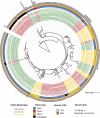Viruses of the Nahant Collection, characterization of 251 marine Vibrionaceae viruses
- PMID: 29969110
- PMCID: PMC6029569
- DOI: 10.1038/sdata.2018.114
Viruses of the Nahant Collection, characterization of 251 marine Vibrionaceae viruses
Abstract
Viruses are highly discriminating in their interactions with host cells and are thought to play a major role in maintaining diversity of environmental microbes. However, large-scale ecological and genomic studies of co-occurring virus-host pairs, required to characterize the mechanistic and genomic foundations of virus-host interactions, are lacking. Here, we present the largest dataset of cultivated and sequenced co-occurring virus-host pairs that captures ecologically representative fine-scale diversity. Using the ubiquitous and ecologically diverse marine Vibrionaceae as a host platform, we isolate and sequence 251 dsDNA viruses and their hosts from three time points within a 93-day time-series study. The virus collection includes representatives of the three Caudovirales tailed virus morphotypes, a novel family of nontailed viruses, and the smallest (10,046 bp) and largest (348,911 bp) Vibrio virus genomes described. We provide general characterization and annotation of the viruses and describe read-mapping protocols to standardize genome presentation. The rich ecological and genomic contextualization of hosts and viruses make the Nahant Collection a unique platform for high-resolution studies of environmental virus-host infection networks.
Conflict of interest statement
The authors declare no competing interests.
Figures


Dataset use reported in
- doi: 10.1038/nature25474
Similar articles
-
A major lineage of non-tailed dsDNA viruses as unrecognized killers of marine bacteria.Nature. 2018 Feb 1;554(7690):118-122. doi: 10.1038/nature25474. Epub 2018 Jan 24. Nature. 2018. PMID: 29364876
-
Acidianus Tailed Spindle Virus: a New Archaeal Large Tailed Spindle Virus Discovered by Culture-Independent Methods.J Virol. 2016 Jan 13;90(7):3458-68. doi: 10.1128/JVI.03098-15. J Virol. 2016. PMID: 26763997 Free PMC article.
-
Virus-host interactions predictor (VHIP): Machine learning approach to resolve microbial virus-host interaction networks.PLoS Comput Biol. 2024 Sep 18;20(9):e1011649. doi: 10.1371/journal.pcbi.1011649. eCollection 2024 Sep. PLoS Comput Biol. 2024. PMID: 39292721 Free PMC article.
-
Antagonistic coevolution of marine planktonic viruses and their hosts.Ann Rev Mar Sci. 2014;6:393-414. doi: 10.1146/annurev-marine-010213-135108. Epub 2013 Aug 28. Ann Rev Mar Sci. 2014. PMID: 23987913 Review.
-
From deep sequencing to viral tagging: recent advances in viral metagenomics.Bioessays. 2013 May;35(5):436-42. doi: 10.1002/bies.201200174. Epub 2013 Mar 1. Bioessays. 2013. PMID: 23450659 Review.
Cited by
-
Viral Satellites Exploit Phage Proteins to Escape Degradation of the Bacterial Host Chromosome.Cell Host Microbe. 2019 Oct 9;26(4):504-514.e4. doi: 10.1016/j.chom.2019.09.006. Cell Host Microbe. 2019. PMID: 31600502 Free PMC article.
-
The oral microbiome: diversity, biogeography and human health.Nat Rev Microbiol. 2024 Feb;22(2):89-104. doi: 10.1038/s41579-023-00963-6. Epub 2023 Sep 12. Nat Rev Microbiol. 2024. PMID: 37700024 Free PMC article. Review.
-
Unprecedented Diversity of Lactococcal Group 936 Bacteriophages Revealed by Amplicon Sequencing of the Portal Protein Gene.Viruses. 2019 May 16;11(5):443. doi: 10.3390/v11050443. Viruses. 2019. PMID: 31100780 Free PMC article.
-
Large language models improve annotation of prokaryotic viral proteins.Nat Microbiol. 2024 Feb;9(2):537-549. doi: 10.1038/s41564-023-01584-8. Epub 2024 Jan 29. Nat Microbiol. 2024. PMID: 38287147 Free PMC article.
-
Resolving the structure of phage-bacteria interactions in the context of natural diversity.Nat Commun. 2022 Jan 18;13(1):372. doi: 10.1038/s41467-021-27583-z. Nat Commun. 2022. PMID: 35042853 Free PMC article.
References
Data Citations
-
- 2016. GenBank. MG592390-MG592672
-
- Kauffman K. M., et al. . 2018. figshare. https://dx.doi.org/10.6084/m9.figshare.c.4028239 - DOI
Publication types
MeSH terms
Associated data
LinkOut - more resources
Full Text Sources
Other Literature Sources

